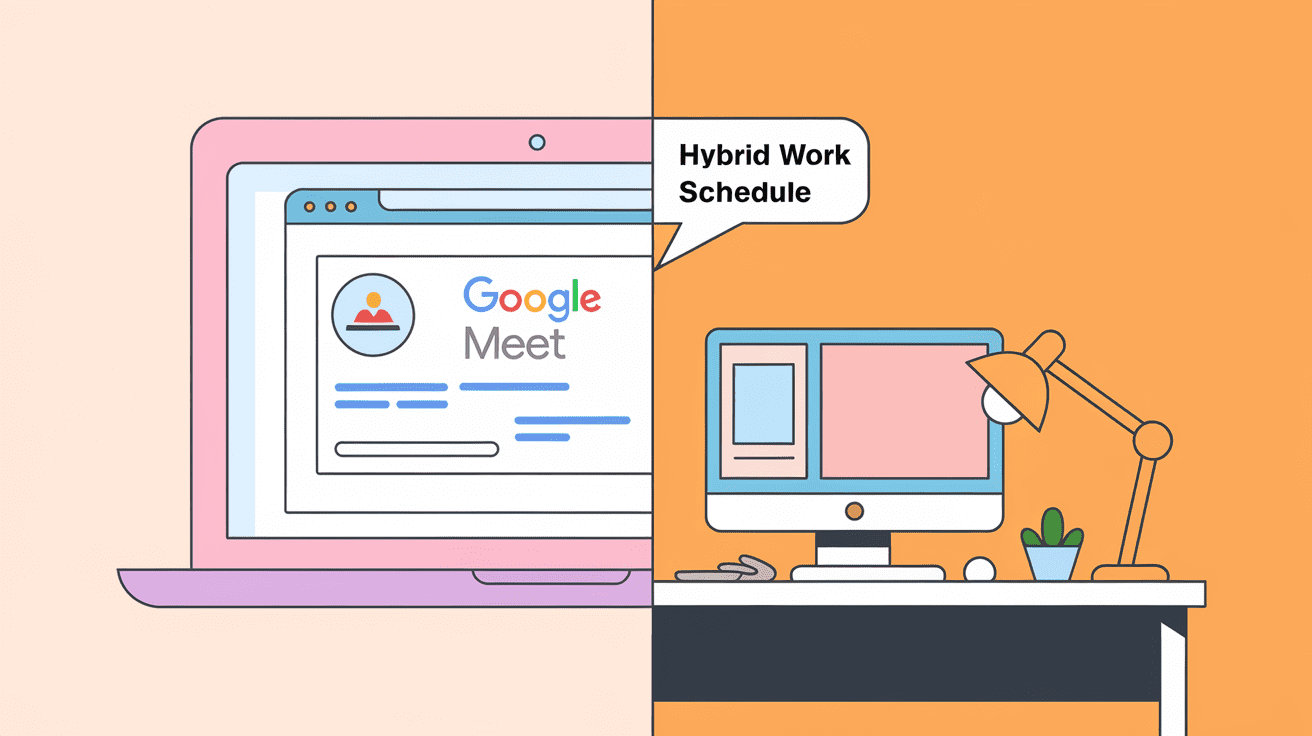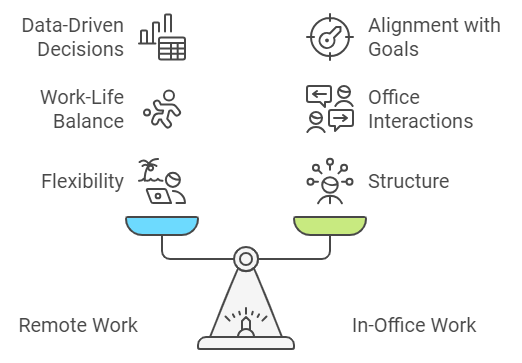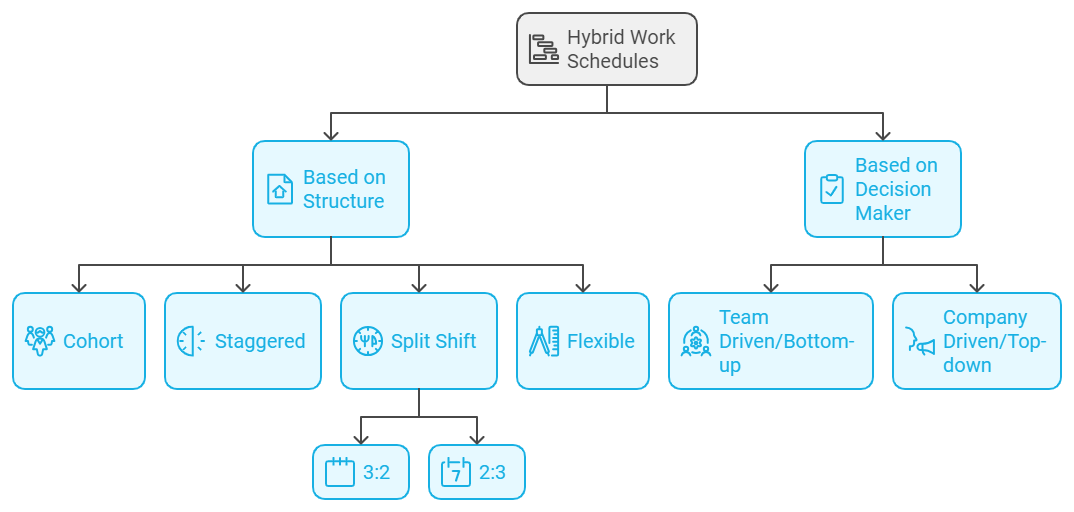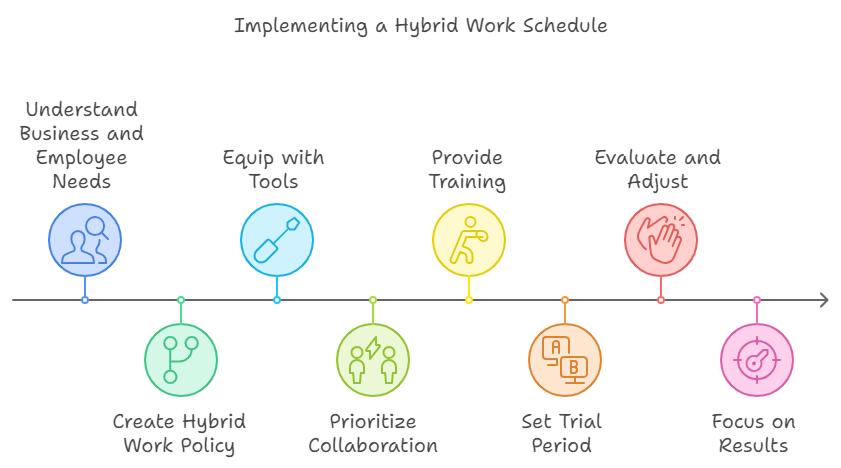Hybrid Work Schedule: Types, Examples, & Challenges!

Picture this: It's Monday, and I'm still in my fuzzy slippers, sipping coffee while joining our morning team call.
Fast forward to Wednesday, and you'll find me downtown in the office, brainstorming with my team members. This is what hybrid work looks like for me.
A hybrid schedule offers you the most needed flexibility without even compromising productivity. It helps you reduce stress by providing control over how and where you work.
With that in mind, let’s walk you through the ins and outs of the hybrid work schedule. Here I’ll discuss:
- What exactly is the hybrid work schedule
- Hybrid work schedule types and effective ways to implement
- How it can benefit you and your team
What is A Hybrid Work Schedule?

It allows you not to be stuck as a full-time office worker or full-time remote worker. Employees can have an ideal mix based on their needs and preferences.
It offers:
- Alignment: Align employee skills with organizational goals via office and remote work.
- Data-driven decisions: Use workplace analytics to optimize the mix of office and remote work.
- Future readiness: Prepares companies for future changes, ensuring flexibility and workplace adaptability.
“Hybrid work setup is no longer just an employee perk but an employee expectation.”
- Ranjit Atwal, Senior Director Analyst at Gartner.
Types of Hybrid Work Schedules
If you don’t have a clear understanding of the hybrid work schedule, you will find it challenging to decide efficiently. Hence, I’ll break down this blended work model type for a clear insight.

Based on Structure
Hybrid work setups have different types based on the structure. For instance-
1. Cohort
A cohort work schedule is a planned hybrid work model. In this model, the employees have to follow the defined schedule decided by their managers.
The advantage? This planned approach enhances collaboration and consistency. Moreover, it ensures that everyone is on the same page regarding workdays and responsibilities.
For instance, your company can schedule office work on Mondays and Tuesdays and work from home Wednesday to Thursday, or vice versa.
2. Staggered
A staggered hybrid working is more rigid than the cohort schedule. Here, the employers set the in-office and remote work days like cohort schedules. However, they can also determine the employees' arrival and departure times.
In this schedule, the employers expect their employees to come on a specific day at a specific time. As I’ve seen, the schedule works best for shift-based companies.
Like the healthcare and education industries. Because the employers can ensure there is adequate coverage and essential services are available.
For example, in a healthcare facility,
- Nurses may work in the hospital from 8 AM to 4 PM on Mondays, Wednesdays, and Fridays.
- Administrative team may work from 10 AM to 6 PM on those same days
- Both groups work remotely on Tuesdays and Thursdays.
3. Split Shift
Split shifts are divided the entire week so that the employees can work in the office for a set number of days.
They can work from home on the other days of the week. However, here, the number of days is set in advance.
Two types of hybrid work split schedules are generally used.
Three Days On-Site, Two Days Remote [3:2]
In this 3:2 hybrid work approach, the employee will work three days onsite and two days remotely in the workweek.
Two Days On-Site, Three Days Remote [2:3]
Unlike before, 2:3 hybrid work has more remote days and fewer office days. The schedule required the employees to come into the office two days in a workweek and remote work in the remaining 3 days.
4. Flexible
As the name defines, the flexible work model has no hard or set rules for scheduling. Two types of hybrid work flexibility are generally used.
Flexi Place
Flexi Place allows employees to decide where they would like to work on any day of the workweek.
In this schedule, it's okay to allow them to choose remote or office work as long as they complete their workweek hours.
Flexi Time
Flexi time schedule lets the employees set their own start and end times for work. However, they must be available during the core hours of the organization set by the management.
Based on Decision Maker
Based on decision-makers, you can also see some types of hybrid work schedules. For instance,
1. Team Driven/Bottom-up
In the team-driven hybrid work model, your employees can decide when to work from the office and when to work from home for their well-being. However, the managers may set the rules.
Like 3 days of onsite work and 2 days of remote work. But your employees will get the freedom to choose which specific day they’ll come or work from home.
A team-driven/bottom-up schedule ensures flexibility with better face-to-face interaction.
2. Company Driven/Top-Down
In this company-driven hybrid work approach, your company will decide when the employees will work from home and when they will work from the office.
The management team can set the schedule team by team or can apply the same rule for everyone.
Further read: 15 Effective Work Schedule Types
How to Implement Hybrid Work Schedule
Well, you will need strategic planning to implement the hybrid work schedule to make the most of it. My suggestions? Follow up on best practices for hybrid work below.

Step 1: Understand the needs of your business and employees.
The first step toward a successful hybrid work schedule is to understand why your employees need it. Moreover, assess what their expectations are from it or whether it is beneficial for your business.
Understanding this hybrid work motivation will help you design a truly beneficial flexible work policy. For detailed insights, I suggest conducting a survey or holding an open discussion.
Step 2: Create a clear hybrid work policy.
Now craft a clear and comprehensive hybrid work policy with the insights. You have to establish clear guidelines when you’re expecting your employees to work from home and office.
It’ll ensure consistency and will set clear expectations for the employees. Moreover, you can reduce the chances of confusion and boost productivity.
Step 3: Equip yourself and your team with the right tools.
To ensure a seamless hybrid work environment, you need to invest in effective tools and infrastructure to maintain real time collaboration. This workplace technology may include:
- Reliable internet access
- Secure VPN connections
- Remote productivity tools
- Task management tools
It is also equally important to set a comfortable and efficient home office environment so that employees can work at their best.
Further Read: 30+ Best Productivity Tools for Remote Teams
Step 4: Make collaboration a priority.
You have to take measures so that the employees can collaborate effectively. It shouldn’t matter where they are working.
It might mean that you need to invest in remote collaboration tools or redesign our office for better hybrid teamwork and meeting accommodation.
Step 5: Provide adequate training.
Now that you’ve ensured the necessary tools and technology, you must provide training on this system. This hybrid work tools training allows your employees or managers to complete their work efficiently.
And in remote onboarding, you can bring both your hires and managers in the meeting so they get along from the get-go.
Step 6: Set a trial period.
My best piece of advice for implementing hybrid work–set a trial period! I can tell from my experience that changes are difficult for any business.
But by setting a trial period, you can test the new setup and let everyone express their thoughts.
It’ll offer you an opportunity to see how well your team is adapting to this change and maintaining productivity.
Step 7: Evaluate the process and make changes.
Let’s say your trial period is a success, and you’ve decided on a hybrid work environment.
Still, you should check process improvement and have a hybrid work evaluation regularly. Work policies are bound to change, and so is hybrid work.
Hence, make evaluation a priority. It’ll also allow you to identify what’s working and what’s not. As a result, you can make necessary adjustments timely.
Further Read: How to Track Employee Performance
Step 8: Focus on results over presence.
Lastly, always keep in mind that results should be valued over physical presence in hybrid work.
You should trust your employees to manage their time effectively. Instead of micromanaging the work process, focus on achieving the outcome!
How Does A Hybrid Work Schedule Benefit Employees and Businesses?
Stanford professor Nick Bloom predicts that 50% of jobs will shift to a hybrid schedule in the near future. But what will be exactly behind this trend?
Let me give you some good enough reasons for how a hybrid schedule benefits both employee engagement and productivity management.

Improves flexibility and employee satisfaction.
Many professionals recognize the ideal work schedule combines both in-office and remote work rather than choosing one or another.
A hybrid work environment allows employees greater autonomy to balance professional responsibilities and their personal life commitments. Ultimately, it leads to higher job satisfaction.
Moreover, employees can adjust their workplace based on their preferences. It helps them to focus and feel less stressed.
The Gallup report shows that a hybrid work schedule has improved the work-life balance of 76% of employees.
Balances focus time and collaboration.
A hybrid work schedule can ensure a perfect balance between employee’s individual work and team collaboration.
It allows them to dedicate remote days to focus on their individual tasks. No office work distractions!
At the same time, office days encourage teamwork. In-person meetings and collaboration create a balanced approach that enhances productivity.
Hybrid workers are likely to be 1.9 times more engaged than the remote worker and 1.7 times more engaged than the on-site worker.
Further Read: 11 Ways To Increase Employee Productivity
Reduces costs.
By implementing the hybrid schedule, companies can experience a marked reduction in their costs.
The reason? You can downsize or reduce the overhead costs on office space or materials due to the fewer office days. But that also depends on what type of hybrid schedule you use.
For instance, if the team alternates different days, fewer desks will be required. But if everyone comes on the same day, you’ll need desks for each one.
Helps to attract and retain a talented workforce.
A hybrid work schedule can increase employee engagement and retain the workforce. It offers flexibility and supports work-life balance, appealing to job seekers and current employees.
Employee turnover results are also encouraging with the hybrid work schedule. A newly published study in the journal ‘Nature’ uncovered compelling evidence for this.
Trip.com, one of the world's largest Chinese online travel agencies, experienced resignations falling by 33% when workers shifted from full-time office work to a hybrid schedule.
Reduces commute time.
As I have experienced, commute time has a great impact on the health and satisfaction of the employees. Research says that longer commute time reduces satisfaction in both work and life.
But a hybrid work schedule allows your employees a better work-life balance, letting them work from home even just a few days a week.
As a result, reduced commute time, increased satisfaction, and enhanced productivity in hybrid work.
"If managed right, letting employees work from home two or three days a week still gets you the level of mentoring, culture-building, and innovation that you want."
- Nicholas Bloom, Senior fellow SIEPR, Stanford Economist
Further Read: How to Make The Most Of Your Virtual Commute
Challenges for Hybrid Work Schedule
Although beneficial, the hybrid work schedule is not free of challenges. Let me discuss with you the challenges of flexible work arrangements that I've come to experience so far.

Potential productivity concerns
True, in most cases, hybrid work can enhance productivity. But honestly, that’s not the case for every employee.
I have personally seen that some employees get distracted while working from home, such as by TV, laundry, or a family member.
Moreover, remote workers who aren’t hitting their targets can sometimes go unnoticed for a long time.
In this case, productivity analytics and remote employee monitoring can efficiently help minimize hybrid productivity issues.
Accountability and trust problems
A recent study by Microsoft shows that 85% of leaders have trouble trusting their remote employees are working.
Some managers find it harder to track their employee's work without having them at their desks. This again translates to the importance of effective productivity tracking tools!
For being on the safe side it’s sometimes better to monitor employee internet usage and online activities as well.
Further Read: Best Time Tracking Apps For Productivity!
Chances for miscommunication and collaboration issues
Collaboration issues may also arise with hybrid teamwork.
The teams are spread out at different locations, and collaboration may become challenging. This can threaten the company's productivity and your project's success.
Additionally, without a clear hybrid work policy, the schedule can lead to miscommunication or unavailability when needed.
All these things can markedly contribute to slowing down the progress and the quality of work.
Weakening social connections and culture-building
To be honest, calling your employees in the office won’t do much to enhance collaboration and engagement until you take some specific measures.
Hybrid culture building may sometimes lead to weak social connections. As far as I’ve seen, people can feel lonely, stressed, or disconnected when the team dynamics are not strong enough to motivate them.
Hybrid culture-building requires a focus on workplace inclusivity to ensure remote and onsite employees feel equally connected to the team and company mission.
Legal Considerations For Hybrid Work Schedules
With the increased popularity of the hybrid work schedule, addressing legal issues has also become a major concern for companies. Below are some things to consider.
Work Location Consistency
You have to ensure that the location of the employees is accurately recorded in all systems, including payroll.
Ten states and Washington, D.C., require employers to pay back employees for work-related expenses. For instance, office supplies and utility bills. Keep correct records to avoid legal issues.
Tax Implications
Tax implications may arise in the states where their company isn’t registered or operates. It may potentially create a business presence known as Nexus.
It can create additional tax obligations. States have different rules on income tax withholding. It influences where the work is performed or where the employees reside.
Wage and Hour Laws
Compliance with the state and federal laws for wages is crucial for nonexempt employees.
You should review the policies and ensure compliance with the Fair Labor Standards Act (FLSA). Moreover, you should work with remote work tools for accurate timesheet tracking.
Conclusion
A hybrid work schedule can remarkably enhance productivity and satisfaction in your business operation.
However, you must ensure clear communication and understand the employee expectations for office and remote work balance.
Make sure to have the right tools, like Apploye, Clickup, Slack, etc, to minimize the operational and legal challenges of this hybrid schedule. With strategic planning, you can achieve a successful hybrid work environment!
FAQs
What does hybrid work mean?
Hybrid work is a flexible work model. It combines both remote and in-office schedules. The schedule allows the employees to balance their personal and professional lives, maintaining productivity.
What is a 3-day hybrid schedule?
Also known as the 3:2 hybrid work model, the 3-day hybrid work schedule allows the employees to work in an office for 3 days and remotely for 2 days. The schedule offers remote work flexibility and in-person collaboration.
How does a hybrid work schedule work?
The hybrid work model combines both remote and onsite work. It offers a flexible work environment, which ensures a better work-life balance. Still, it offers in-person collaboration and maintains productivity.
Similar articles:
